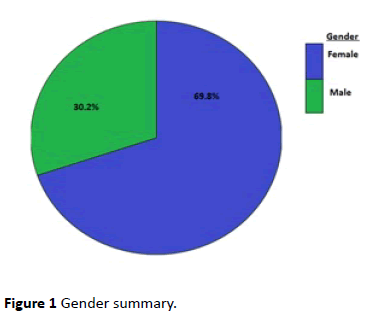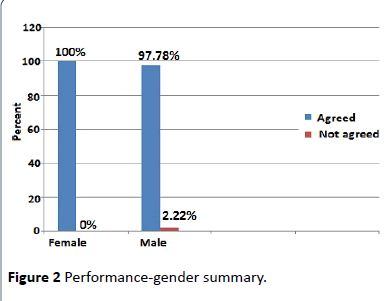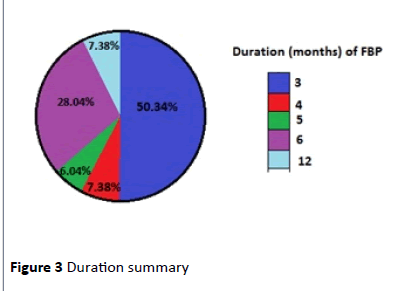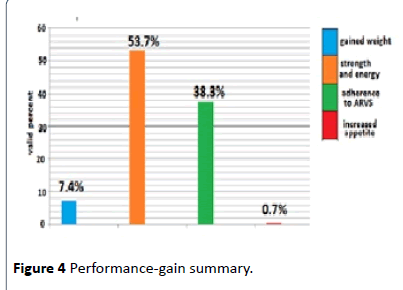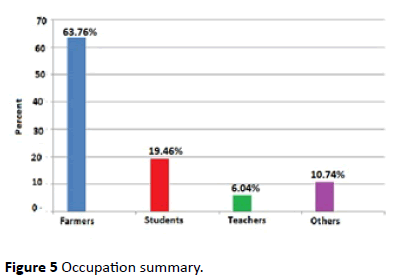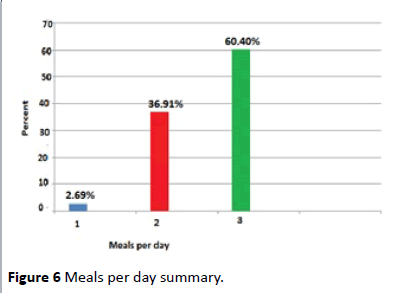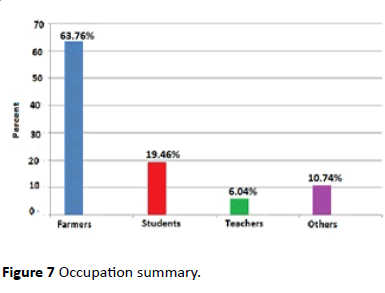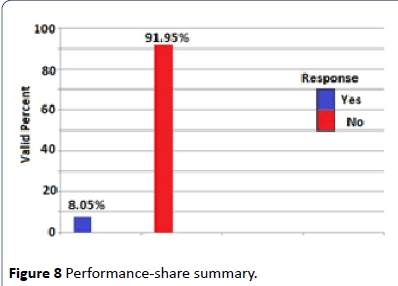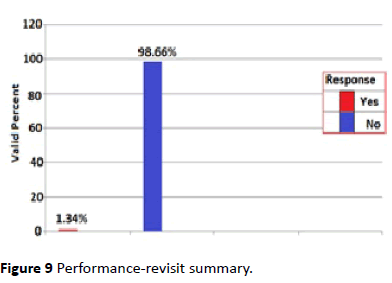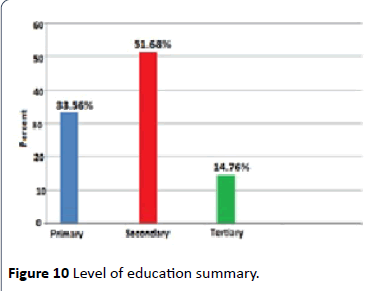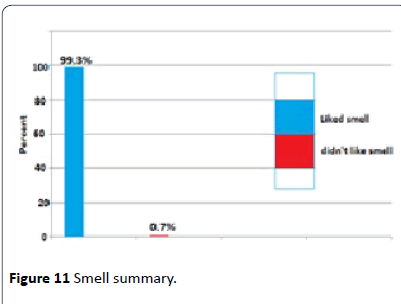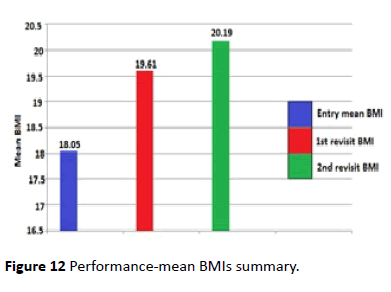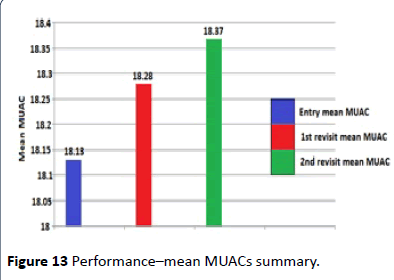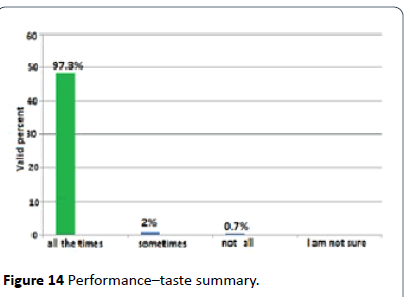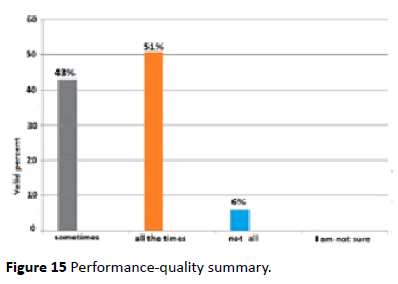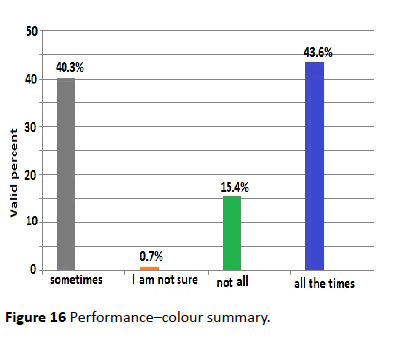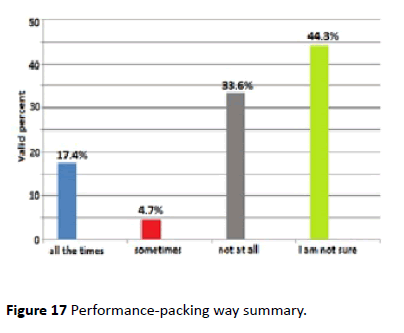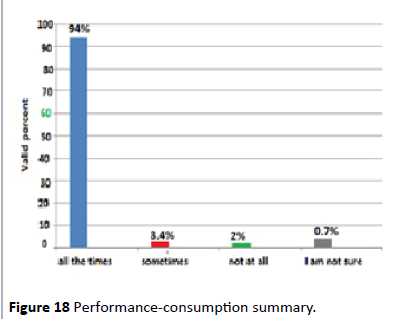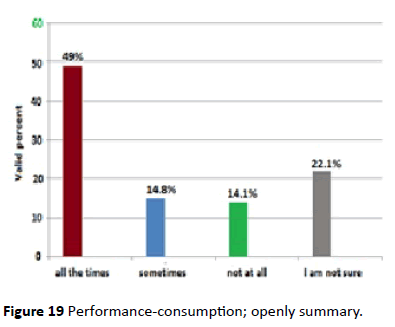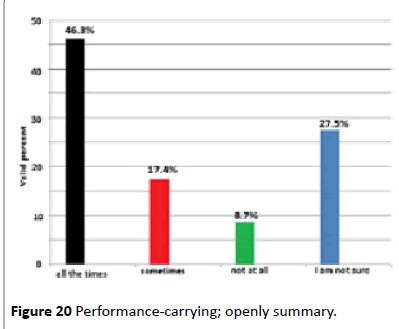Keywords
Nutritional health; Significant weight loss; HIV
Introduction
And early death [1-6]. Malnutrition is also associated with
poor birth out-comes among HIV-positive women [6-12].
Moreover, access to adequate nutritious food is especially
difficult for PLWHIV/AIDS as the illness often reduces
household productivity and income as well, forcing families to
sell productive assets, spend savings on food and medicine,
and withdraw children from school to put them to work or
care for HIV-positive adults [10, 11]. Never the less, the
program has been there for the last one decade. The program has indeed boosted the efforts of managing the burden caused
by HIV. Many clients have indeed responded well to both
supplemental and therapeutic feeds provided by the program.
The adherence to Ant-Retroviral Therapy (ART) is currently
good due FBP. While the benefits are enormous of the
program, Gucha Sub-county for example has realized that
clients who merit to the program take more than three months
to graduate/discharge. Others even take more than a year (50
clients of 1175 took more than a year in the program). This is
according to Gucha NASCOP Report- 2014. So it is not known
how long the client should stay in the program. In Ethiopia,
they have spread it from 4 months to 6 months. Again, the
program has not been evaluated to determine its success in
Gucha Sub- County in general. Furthermore, the clients who
happen to come from a poor resource set-up families, when
exit the program, it is not clear what they do to maintain their
restored weight. Therefore, my study will try to find out these
in Gucha Sub-county.
Who are the eligible beneficiaries?
The first category is for those who are HIV-positive and are
at least 6 months old and who are malnourished (undernutrition).
The second category is for those ones (children) who
are orphaned and vulnerable [12-20]. In my case, I will deal
with the first category, for the malnourished HIV-positive
clients.
Global view on FBP
In less than a decade, multiple FBP programs have been
designed to meet needs of malnourished clients, who are HIVpositive
[21, 22]. The World Health Organization looks at
fighting the burden of HIV/AIDS through one part of
supplementation and another part of treatment (ART).
Although HIV testing is increasingly available and efforts to
support the nutritional needs of people living with HIV have
intensified appreciably, anti-retroviral therapy (ART) service
providers continue to report large numbers of clients
presenting with advanced disease and acute malnutrition. In
some ART programs, as many as 33% of all first-visit clients are
unable to walk into the clinic without assistance, correlating with high rates of mortality in the 90 days of treatment. In
response, there has been a rapid proliferation of Food by
prescription (FBP) programs, designed to ensure efficient and
effective nutrition care rehabilitation for people enrolled in
HIV care and treatment programs [9]. Marston , in his Journal
of Medicine, 2004, indicated that,” FBP had attracted a
plethora of donors and stake holders: multiple UN agencies
including WFP, WHO, UNICEF,USAID’s Food for peace
(FFP),CDC,GFATM, and Nutrition Technical Assistance Project
(FANTA) [23-25].
The Ethiopian view on FBP
Nutrition interventions have been successful in Ethiopia in
the management of HIV/AIDS and many clients enrolled into
such programs have markedly improved both their body
weight and general health [9]. The FBP program is one of the
strategies that addresses under nutrition among the PLWHIV/
AIDS and their vulnerable family members through proper
nutritional assessment, counseling and support (NACS) [8, 9].
With Ethiopia beginning this program in 2010 [10]. The
foods and ministry of health of Ethiopia launched a
comprehensive National Nutrition Program, which included
nutrition and HIV/AIDS as part of its complete service delivery,
and also emphasized the linking of nutrition and HIV/AIDS
programs with other livelihood programs [11].
Ethiopia has integrated HIV and nutrition interventions
based on the patient’s nutritional status [9,13].
The Kenyan view on FBP
The Kenya National HIV/AIDS strategic plan and National
health sector strategic plan (2005-2010) underlined the need
to effectively address malnutrition among people living with
HIV infection and those affected by the pandemic. In line with
this position and with support from the President’s Emergency
Fund for AIDS Relief (PEPFAR), USAID/Kenya initiated a food by
prescription program in collaboration with the National AIDS
and STI control program (NASCOP) in the ministry of health
(MOH) Insta products Ltd. (Kenya). At the time of this review in
November 2007, the program provided fortified blended flour
(FBF) by prescription to malnourished adults living with HIV,
HIV-positive pregnant and post-partum women (P/PP) and
orphans and vulnerable children (OVC) who are either clinically
malnourished or at risk of malnutrition. This was to make HCPs
get to understand about FBP so as to strengthen the program.
Gucha sub-county
Gucha is one of the sub-counties in Kisii County, Kenya. It is
inhabited by members of Abagusii community and has a
population of approximately 105,000 people who are mainly
small scale farmers. It covers an area of 105 square kilometers,
with a population density of 955 persons/square kilometers.
The ratio of female to male is 13:12 and has a population
growth of 2.3%. It borders Kenyenya to the South, Nyamache
to the East, south Mugirango to the West, and Nyaribari
chache to the North. It is a rich agricultural land that is
devoted to farming, with heavy rainfall throughout the year
(CBS 2009). It has three administrative locations and its security is good. However, HIV preference is 8% 1032 clients
are put on Care and ART for both ARVs and FBP. Food
supplements and therapeutic feeds are always prescribed to
those clients who meet the requirements for
supplementation. Nevertheless, some clients do not take the
normal time of three months to graduate. This means that
these clients remain in the program for longer time than
expected. The minutes of the Sub-county Health Management
Team (SHMT) coordinated by the Sub-county Medical Officer
of Health (SMOH) shows that adherence to the ARVS is greatly
affected by malnutrition. In this regard, it is quite noting that
there could be factors associated with FBP use among the
PLWHIV/AIDS. The FBP program at the sub- county level is
coordinated by the sub-county nutrition officer of health
(SNOH) and care is available free at all government health
facilities [26-28].
Statement of the problem
In less than a decade, the country has witnessed a
proliferation of Foods by Prescription program (FBP) to all
Patient Support Centers (PSC). The program has indeed
boosted the efforts of managing the burden caused by HIV.
Many clients have indeed responded well to both
supplemental and therapeutic feeds provided by the program.
The adherence to Ant-Retroviral Therapy (ART) is currently
good due FBP. While the benefits are enormous of the
program, Gucha Sub-county for example has realized that
clients who merit to the program take more than three months
to graduate/discharge. Others even take more than a year (50
clients of 1032 took more than a year in the program). This is
according to Gucha NASCOP Report-2014. So it is not known
how long the client should stay in the program. In Ethiopia,
they have spread it from 4 months to 6 months. Again, the
program has not been evaluated to determine its success in
Gucha Sub-County in general. Furthermore, the clients who
happen to come from a poor resource set-up families, when
exit the program, it is not clear what they do to maintain their
restored weight. Therefore, my study will try to find out these
in Gucha Sub-county and advice accordingly [29].
Justification of the study
No research has been done in Gucha Sub-county and even
the entire Kisii County which has evaluated the FBP program.
By doing this research, the findings will help the policy makers
and implementers, and stakeholders prepare proper utilization
of FBP. Furthermore, it will help them find a solution for those
clients from a poor resource set-up, who have been in the
program and have been discharged, to continue with their
normal life without supplements.
Significance of the study
Understanding the FBP program enhances ART adherence of
HIV positive people and the factors hindering the same
process. Therefore proper formulation of policies will be
arrived at by the policy makers and stakeholders and will help
in the formulation of strategies geared towards the reduction of the burden caused by the disease (HIV/AIDS) and improve
productivity amongst people with the disease. The findings,
therefore, can also be used to develop statistical model that
can be used to improve the adherence of foods by prescription
supplement use well among the PLWHIV/AIDS.
Scope of the study
The study is focusing on the FBP program which is used by
people living with HIV/AIDS in Gucha sub-county, in Kisii
County, Kenya. Only those who are enrolled in the program of
Foods by Prescription will be interviewed from the category of
PLWHIV/AIDS. 8 PSC facilities will be involved in the study.
Limitation of the study
The study looks at Foods by Prescription supplement use
among the PLWHIV/AIDS, and therefore, does not involve
other foods which are not prescribed for. Again not all people
who are living with HIV/AIDS, the study (research) can benefit.
Research Methodology
Location of the study
The study was carried out in Gucha sub-county which is one
of the nine sub-counties in Kisii County. It borders Nyaribari
chache to the North, South Mugirango to the West, Nyamache
to the East and Kenyenya to the South. It has approximately
105,000 people. 8 PSCs were involved in the study; the subcounty
referral hospital, one model health center and six
dispensaries. These were the only facilities that offered PSC
services.
Study design
This was a cross-sectional study which used both
quantitative and qualitative methods. All clients, who were in
the program of FBP, were interviewed through informant
interviews. And a checklist was used to extract the BMIs and
MUACs of the clients through observation.
Study population
We used inclusive and exclusive criteria for study
population, and willingly were asked to be interviewed
through informant interviews. Respondents who were less
than 11 years were not interviewed. Those above 11 years but
less than 80 years were interviewed. Bed-ridden respondents
were not interviewed.
Sampling techniques
Fisher’s formula (1997) was used to determine the sample
size based on the clients attendance.
N=Z2PQ/D2
Where,
N=desired sample greater than 10000
Z=the normal deviation of 95% confidence interval (1.96)
P=the proportion in the target population estimated to be in
the program of FBP (malnourished prevalence for HIV
clients=50%, according to Gucha SCHIS report for NASCOP,
2014).
Q=1-P
D=level of precision (set at +-5% or +-0.05)
By substituting the figures,
n=382.16
=382
Since the population was less than 10000, (1032clients who
were on care and ART, 2014 cumulatively. WHERE, ADULTS
WERE=978 & CHILDREN WERE=54), the following formula;
finite populations correction of proportions was used to
correct and come up with the final sample size.
NOTE:
FBP is a quarterly program.
Then,
nf=n/(1+(n/N))
=382.16/(1+382.16/258)
=154
Sampling method
Stratified sampling method was used in this study. The subcounty
was divided into 8 (eight) catchment populations/
strata representing eight facilities. The criteria of inclusive and
exclusive method was used; Less than 11 years respondents
were not interviewed, those above 80 years too were not and
bed-ridden respondents equally were not interviewed.
Respondents who were between 11 years and 80 years were
interviewed.
NOTE: Caretakers were not allowed to participate in the
interviews.
Instruments
The study used a semi-structured questionnaire to collect
primary quantitative and qualitative data. A checklist was used
for observational data, i.e., BMIs and MUACs of program
respondents. MUAC tapes, BMI wheels and scientific
calculators were used to identify nutrition status of the
respondents.
Reliability
Was determined by pre-testing the questionnaire, by use of
the test and retest method at Gucha sub-county hospital, using
respondents who were not part of the study sample. The
research assistants who administered the questionnaire were
trained on questions thus ensured uniformity.
Validity
The research used quantitative and qualitative variables
which were explanatory variables to test for validity of
research instruments.
Piloting
Ten questionnaires were administered at Gucha sub-county
for suitability and result put on excel for scrutiny.
Data collection procedures
The questionnaires were administered by research
assistants, using English and Ekegusii languages. This facilitated
uniform understanding of the questions because some of the
respondents were not well conversant with English language.
Eight medical training college students on sub-county
experience (community health and extension students) were
trained on the purpose of the study, the objectives, so as to
translate into local dialect. Checking questionnaires for
completeness was done for accuracy of data collected.
Data analysis and presentation
The questionnaires were checked for completeness and
consistency of information at the end of every data collection
day and before storage. Data captured were done using Excel
software. The data from the completed data were cleared,
recorded, coded and entered into the computer using the
statistical package of social sciences (SPSS) version 17.0 for
windows for analysis. Basic descriptive statistics and charts
were used to summarize the findings; attitude of the client
living with HIV towards FBP, evaluation of the performance of
the program and factors that affect the performance in a poor
resource set-up through mean or proportion. All continuous
variables were presented as mean, median or proportion.
Categorical variables were presented as bar charts or pie
charts. Correlation analysis was used to examine the
relationship between dependent variable and explanatory
variables on FBP program.
Results and Discussion
Performance of FBP program among the
PLHIV/AIDS
One way of addressing malnutrition among HIV/AIDS
patients is through food by prescription program (FBP).
Available evidence on adherence levels and factors associated
with these sorts of programs are limited. The study was
conducted among 149 patients in the quantitative study with a
100% response rate as witnessed in the (Table 1).
| Gender |
Cases |
| Valid |
Missing |
Total |
| N |
Percent |
N |
Percent |
N |
Percent |
| Do you feel it is of some help to your health? |
149 |
100.00% |
0 |
0.00% |
149 |
100.00% |
Table 1: The study was conducted among 149 patients in the quantitative study with a 100% response rate as witnessed.
Of these, 104 (69.8%) of the respondents were female and
45 (30.2%) were male, their ages ranged from 11 years to 74
years a range of 64 years and a mean of 36.01 years. From the
study it was found out that of the respondents, 117 (78.52%)
their BMI was recorded and a partly 32 (21.48%) their BMI was
not recorded the reason being of those who were not
supposed to record the BMI were either expectant mothers or
those below the age of 18 who are by law not supposed to
take a body mass index.
From the study it was also discovered that, 148 (99.33%)
were Christians and 1 (0.64%) were Muslims. No Hindu who
was recorded in the study despite being included in the
questionnaire showing that the scope of the study was not
carried in a cosmopolitan area (Table 2 and Figure 1).
Figure 1: Gender summary.
|
|
Do you feel it is of some help to your health |
Total |
| All the times |
Not all |
|
| Gender |
Female |
104 |
0 |
104 |
| Male |
44 |
1 |
45 |
| Total |
|
148 |
1 |
149 |
Table 2: Of the total respondents 50 (33.56%) did not go
beyond primary level of education, 76 (51.01%) secondary and
another 22 (15.43%) went beyond secondary education.
Table 2 Of the total respondents 50 (33.56%) did not go
beyond primary level of education, 76 (51.01%) secondary and
another 22 (15.43%) went beyond secondary education.
From the study on the performance, on the question on
whether the program is of any help to them, the response was
100%, with 104 (100%) of the female gender agreed, 44
(97.78%) of male also agreed, however 2.22% ( 1) disagreed
that it was not of help at all the time.
It was not understood why he disagreed with the program
as indicated on the table and the pie chart above (Table 3 and
Figure 2).
Figure 2: Performance-gender summary.
| Duration(months) |
Frequency |
Percent |
Valid percent |
Cumulative Percent |
| 3 |
75 |
50.34% |
50.34% |
50.34% |
| 4 |
11 |
7.38% |
7.38% |
57.72% |
| 5 |
9 |
6.04% |
6.04% |
63.76% |
| 6 |
43 |
28.86% |
28.86% |
92.62% |
| 12 |
11 |
7.38% |
7.38% |
100% |
Table 3: The duration of FBP.
Is the duration of FBP enough?
More than half of the respondents, 75 (50.34%) agreed that
the duration was enough, however the rest differed with the
duration.
11 (7.38%) of them, said that they want the program added
one more month (4 months), 9 (6.04%) of the respondents
said that the program should be added two more months (5
months), 43 (28.86%) of the respondents, said the program to
be added three more months (6 months) and the rest, 11
(7.38%) of the respondents, said that they wanted the
program to be added 9 more months (12 months).
Most of those who disagreed with the duration come from a
poor resource set-up. In general, the duration was enough as
per the most respondents, who agreed with it (Table 4 and
Figure 3).
Loss of weight, weak and loss of appetite, hence chronic
energy deficiencies, happens to be symptoms of HIV and AIDS,
but from the study respondents argued why the program was
of help to them, 11 (7.4%) said they had gained weight this can
be attributed from the BMI and MUAC that were carried on
relevant groups, 80 (53.7%) gained energy and were strong, 57
(38.3%) made them adhere to ARVS and 1 (0.7%) argued that
his/her appetite had improved, in general the program had a
tremendous positive impact among PLWHIV/AIDS which makes the program more popular for management of malnutrition
among PLWHIV/AIDS (Figure 4).
Figure 3: Duration summary.
|
Frequency |
Percent |
Valid Percent |
Cumulative Percent |
| Valid gained weight |
1100.00% |
7.4% |
740.00% |
7.4 |
| strength and energy |
80 % |
53.7% |
53.7% |
61.1 |
| adherence to ARVS |
57% |
37.6% |
37.6% |
98.7 |
| increased appetite |
1% |
0.7% |
0.7% |
99.3 |
|
|
|
0 |
0 |
| Total |
149 |
100 |
100 |
|
Table 4: Loss of weight, weak and loss of appetite, hence chronic energy deficiencies.
Figure 4: Performance-gain summary.
Table 4 Loss of weight, weak and loss of appetite, hence
chronic energy deficiencies.
Social factors that are affecting the program
Size of the family
The size of the family is a big indicator of the performance
of the program. This is because the program needs food which
accompanies the FBP under the program.
A large family would be strenuous for one to raise enough
food for the program in a setup of poor resource like the
Gucha sub county (Table 5).
| Count |
|
meals_per_day |
|
Total |
|
|
1 |
2 |
3 |
|
| Size of family |
0 |
0 |
16 |
7 |
23 |
|
2 |
0 |
0 |
1 |
1 |
|
3 |
0 |
5 |
13 |
18 |
|
4 |
0 |
7 |
12 |
19 |
|
5 |
1 |
11 |
20 |
32 |
|
6 |
0 |
8 |
13 |
21 |
|
7 |
0 |
4 |
10 |
14 |
|
8 |
0 |
3 |
11 |
14 |
|
10 |
1 |
1 |
3 |
5 |
|
11 |
1 |
0 |
0 |
1 |
|
14 |
1 |
0 |
0 |
1 |
| Total |
|
4 |
55 |
90 |
149 |
Table 5: Size of family meals per day cross-tabulation.
Occupation is also another social economic factor that has
an effect on the program, from the table above a patient who
is a farmer is more likely to have either one meal or 2 meals in
a day this is due to low income associated with this kind of
family set up. This is also the case with a conductor, a driver
and masonry (Table 6).
| Count |
|
Meals per day |
|
Total |
|
|
1 |
2 |
3 |
|
| Occupation |
Farmer |
58 |
35 |
2 |
95 |
|
police officer |
0 |
0 |
2 |
2 |
|
Teacher |
0 |
2 |
7 |
9 |
|
health worker |
0 |
0 |
4 |
4 |
|
Conductor |
0 |
1 |
0 |
1 |
|
Businessman |
0 |
0 |
3 |
3 |
|
Masonry |
0 |
0 |
2 |
2 |
|
pupil/student |
1 |
15 |
13 |
29 |
|
Driver |
0 |
1 |
3 |
4 |
| Total |
|
4 |
55 |
90 |
149 |
Table 6: Occupation meals per day cross-tabulation.
On the other hand an employed officer is likely to have at
least 2 meals in a day, i.e., police officer, a teacher and a health
worker this is because of the income associated with this
occupation. As for the student, he is likely to either have 3
meals 2 or 1 depending on the family he or she hails from.
As far as the study is concerned, occupation is key to the
performance of the program, therefore implementers of the
program should come with ways to empower PLWHIV/AIDS in
generating income from other activities to continue with
normal life after exit of the FBP program; Mostly members
from poor resource set up. In summary, 95 (63.76%) of the
respondents were farmers.
Of these, 58 (61.05%) had one (1) meal, 35 (36.84%) had
two (2) meals and 2 (2.11%) had three (3) meals. For the case
of a teacher, who were 9 (6.04%) of the total respondents, no
teacher who had one (1) meal, 2 (22.22%) had two (2) meals
and 7 (77.78%) had three (3) meals. 29 (19.46%) of the
respondents were students and pupils.
Of these, 1 (3.45%) had one (1) meal, 15 (51.72%) had two
(2) meals and 13 (44.83%) had three (3) meals with their
families.
The rest of the respondents; 16 (10.74%) who represent the
other cadres, 2 (12.50%) of the cadres had two (2) meals while
14 (87.50%) had three (3) meals. There was no case of one
meal in these cadres. Over ally, 4 (2.69%) of the respondents,
had one (1) meal, 55 (36.91%) of the respondents had two (2)
meals and 90 (60.40%) had three (3) meals (Table 7 and
Figures 5 and 6).
Figure 5: Occupation summary.
| Sachets |
Frequency |
percent |
Valid percent |
Cumulative percent |
| 5 |
9 |
11.54% |
11.54% |
11.54% |
| 10 |
25 |
32.05% |
32.05% |
43.59% |
| 15 |
44 |
56.41% |
56.41% |
100% |
Table 7: Option no table.
On whether the FBP was enough, 71 (47.65%) of the
respondents agreed that it was enough while 78 (52.35%)
disagreed. 9 (11.54%) of those who disagreed, said that they
wanted 5 sachets more added, 25 (32.05%) of those who
disagreed said that, they wanted 10 sachets more added, and
44 (56.41%) of those who disagreed said that, they wanted 15
more sachets added.
On whether food was shared, 12 (8.05%) of the respondents
agreed that they share with their children while 137 (91.95%)
of the respondents said they did not share.
Indeed this one affected the fight against malnutrition given
that their BMI/MUAC did improve as expected (Table 8 and
Figure 6).
Figure 6: Meals per day summary.
| Response |
Frequency |
Percent |
Valid percent |
Cumulative percent |
| Yes |
12 |
8.05% |
8.05% |
8.05% |
| No |
137 |
91.95% |
91.95% |
100% |
Table 8: Food supplement.
On whether the respondents missed supplementation
revisit, 2 (1.34%) of the respondents agreed, due to forgetting the return date, 147 (98.66%) of the respondents did not miss.
These respondents did not improve their BMI/MUAC (Table 9
and Figure 7).
| Count |
|
Is FBP of any help to your health |
|
Total |
|
|
Yes |
No |
|
| Level of education |
Primary |
10 |
40 |
50 |
|
Secondary |
50 |
27 |
77 |
|
Tertiary |
22 |
0 |
22 |
| Total |
|
149 |
0 |
149 |
Table 9: Level of education is FBP of any help to your health?
Figure 7: Occupation summary.
The level of education also plays a key role as far as the
program is concerned, from the table above 10 (20%) of the
respondents agreed with the program and 40 (80%) 0f the
respondents who have primary education did not agree that
the program is of help to their health status, secondary level
respondents 50 (64.93%) agreed against 27 (35.07%) who
disagreed with the program on the other hand 22 (100%) of
those with tertiary level agreed that the program was of
benefit.
Therefore low education or rather illiteracy was a hinder to
the program compared to the learned category (Table 10 and
Figure 8).
Figure 8:Performance-share summary.
|
|
Frequency |
Percent |
Valid Percent |
Cumulative Percent |
| Valid |
All the timeSometimesnot all |
145 |
97.3 |
97.3 |
97.3 |
|
|
3 |
2 |
2 |
99.3 |
|
|
1 |
0.7 |
0.7 |
100 |
|
Total |
149 |
100 |
100 |
|
Table 10: The level of education also plays a key role as far as the program is concerned.
Factors that influences the performance of FBP
program in a poor-resource
Smell
As a result of stigma most of the patients in most cases do
not like the smell of the food offered by the program this may
also be attributed to the result of stigma and isolation from
other members of the public from this study as witnessed in
the table smell of the food was not problem as 145 (97.3%)
didn’t have a problem with the smell of the food under FBP
program 3 (2%) liked the smell whereas 1 (0.7%) did not like
the smell all the times, in general smell had no impact on the
program (Figure 9).
Figure 9:Performance-revisit summary.
From the figure above it is clear that the mean BMI in the
first revisit was greater than the entry means BMI and it was
less than the mean BMI in the second revisit.
This shows that the program has a positive impact of
fighting under nutrition among the PLWHA (Figures 10 and
11).
Figure 10:Level of education summary
The patients’ MUAC also shows that there was
improvement; the MUAC was the best indicator of the
respondents’ performance for expectant mothers and those
who are less than 18 years, showing the impact of the
program.
In summary, 32 (21.48%) of the respondents were taken
MUAC when compared to 117 (78.52%) whose BMI were
taken.
Almost all the participants 145 (97.3%) liked the taste of the
food 3 (2.0%) did not like the food all the times and a partly
0.7% did not like the food all the times.
From the above response we can deduce that their attitude
towards the program was positive and other attitude
questions like smell colour package as shown in other tables
(Figure 12).
Figure 12:Performance-mean BMIs summary.
On the quality of the food under FBP program 64 (43.0%)
liked the quality sometimes, 76 (51.0%) liked the quality all the
times and a partly 9 (6.0%) did not like the quality all the
times.
It can therefore be deduced that quality is a hindrance to
adherence of the products among PLWHIV/AIDS (Table 11 and
Figure 13).
Figure 13:PerformanceÃÆÃâÃââÃÆââ¬Å¡Ã¢ââ¬Å¡Ã¬ÃÆââ¬Å¡Ã¢ââ¬Ã
âmean MUACs summary.
|
|
Frequency |
Percent |
Valid Percent |
Cumulative Percent |
| Valid |
Sometimes i am not sure not all the times |
60 |
40.3 |
40.3 |
40.3 |
|
|
1 |
0.7 |
0.7 |
40.9 |
|
|
23 |
15.4 |
15.4 |
56.4 |
|
|
65 |
43.6 |
43.6 |
100 |
|
Total |
149 |
100 |
100 |
|
Table 11: Do you like the colour?
Figure 14:PerformanceÃÆÃâÃââÃÆââ¬Å¡Ã¢ââ¬Å¡Ã¬ÃÆââ¬Å¡Ã¢ââ¬Ã
âtaste summary.
On the colour of the food 60 (40.3%) liked the colour
sometimes, 1 (0.7%) was not sure 23 (15.4%) did not like the
colour all the times and 65 (43.6%) liked the colour all the
times. colour to some extent contributed to negative view of
the program due to the view that its only PLWHA who only
take that kind of food (Table 12 and Figure 14).
|
|
Frequency |
Percent |
Valid Percent |
Cumulative Percent |
| Valid |
Sometimes i am not sure not all the times |
60 |
40.3 |
40.3 |
40.3 |
|
|
1 |
0.7 |
0.7 |
40.9 |
|
|
23 |
15.4 |
15.4 |
56.4 |
|
|
65 |
43.6 |
43.6 |
100 |
|
Total |
149 |
100 |
100 |
|
Table 12: Do you like packing way?
On the question whether the packing of the food was good,
26 (17.4%) agreed that the packing was okay, 7 (4.7%) were
not sure if the packing was okay maybe it’s because they have not seen any packing so they cannot tell if the packing was
okay, however 50 (33.6%) did not like the packing all the times
and the majority of the respondents 66 (44.3%) liked the
packing all the times (Table 13 and Figure 15).
|
|
Frequency |
Percent |
Valid Percent |
Cumulative Percent |
| Valid |
All the times Sometimes not all am not sure |
140 |
94 |
94 |
94 |
|
|
5 |
3.4 |
3.4 |
97.3 |
|
|
3 |
2 |
2 |
99.3 |
|
|
1 |
0.7 |
0.7 |
100 |
|
Total |
149 |
100 |
100 |
|
Table 13: Do you enjoy consuming them?
Figure 15:Performance-quality summary.
A majority of the respondents 140 (94.0%) liked the
consumption of the food all the times showing how popular
the program is against 5 (3.4%) sometimes, 3 (2%) not all the
times and a partly 1 (0.7%) who were not sure of whether they
enjoyed the consumption which may be attributed to the
duration of the program or stigma (Table 14 and Figures 16
and 17).
Figure 16:PerformanceÃÆÃâÃââÃÆââ¬Å¡Ã¢ââ¬Å¡Ã¬ÃÆââ¬Å¡Ã¢ââ¬Ã
âcolour summary.
Figure 17:Performance-packing way summary.
|
|
Frequency |
Percent |
Valid Percent |
Cumulative Percent |
| Valid |
All the times Sometimes not all am not sure |
73 |
49 |
49 |
49 |
|
|
22 |
14.8 |
14.8 |
63.8 |
|
|
21 |
14.1 |
14.1 |
77.9 |
|
|
33 |
22.1 |
22.1 |
100 |
|
Total |
149 |
100 |
100 |
|
Table 14: Do you enjoy consuming them openly?
From the table above, 73 (49.00%) of the respondents
enjoyed consuming the supplements openly all the times, 22
(14.80%) of the respondents said; sometimes, 21 (14.10%) said; not all and another 33 (22.1%) said were not sure (Table
15).
|
|
Frequency |
Percent |
Valid Percent |
Cumulative Percent |
| Valid |
All the times Sometimes not all am not sure |
73 |
49 |
49 |
49 |
|
|
22 |
14.8 |
14.8 |
63.8 |
|
|
21 |
14.1 |
14.1 |
77.9 |
|
|
33 |
22.1 |
22.1 |
100 |
|
Total |
149 |
100 |
100 |
|
Table 15: Do you like carrying them openly from hospital?
From the above table stigma is also a factor that which
hinders the performance of the program 69 (46.3%) could like
carrying the food openly, 26 (17.4%) sometimes carried, 13
(8.7%) did not carry the food all the times and 41 (27.5%) were
not sure (Figure 18).
Figure 18:Performance-consumption summary.
In conclusion; The SPSS print out indicate that the strength
of association between the variables is there (r=0.055 for entry
BMI, r=0.157 for 1st revisit BMI and r=0.339 for 2nd revisit
BMI), and that the correlation coefficient is significantly
different from zero (P<0.001) for 2nd BMI and (0<P<+1) for
entry BMI and the 1st revisit BMI.
Also, we can say that 0.3% (0.0552) of the variation in entry
BMI is explained by the meals per day, 2.47% (0.1572) of the
variation in the 1st revisit BMI is explained by meals per day
and 11.49% (0.3392) of the variation in 2nd revisit BMI is
explained by meals per day.
Summary, Conclusion and
Recommendation
The main focus of the study was to find out if there are
other identified factors that are associated with FBP program
supplement use among the PLWHIV/AIDS, which contribute to
the over stay in the FBP program, evaluate the program and
also assess the attitude of the use among the PLWHIV/AIDS in
Gucha sub-county.
The findings of the study will contribute some knowledge to
stakeholders, policy makers on how to understand the reason
why the program of FBP that is required a patient to takes 3
months only take more than a year to graduate from the
program which is not required.
The study has shown factors that contribute to overstay in
the program. This chapter presents summary of the study and
research finding as per specific objectives of the study,
conclusion and recommendation on the possible ways of
addressing food by prescription program.
Discussion of the Findings
The overall purpose of the study was to evaluate foods by
prescription program supplement use among people living
with HIV/AIDS, in Gucha sub-county in Kisii County and come
up with various proposals on how to improve this program.
The specific objectives of the study were;
• To evaluate performance of FBP program among the
PLWHIV/AIDS.
• To identify factors that influences the performance of FBP
program in a poor-resource set-up among PLWHIV/AIDS.
• To determine attitude of PLWHIV/AIDS towards the FBP
program.
Performance of FBP program among the
PLWHIV/AIDS
From the study to evaluate performance of the program, the
findings showed that 104 (100%) of the female agreed, 44
(97.78%) of the male agreed that the program was of the great
importance, however 2.22% (1) disagreed that it was not of
help at all the time, it was not understood why he disagreed
with the program as indicated on the table and the pie chart
above.
From the study respondents argued why the program was of
help to them, 11 (7.4%) said they had gained weight this can
be attributed from the BMI that was carried on relevant
groups, 80 (53.7%) gained energy and were strong, 57 (38.3%)
made them adhere to ARVS and 1 (0.7%) argued that his/her
appetite had improved, in general the program had a
tremendous positive impact among PLHIV/AIDS which makes
the program more popular if applied regularly.
The patients MUAC also shows that there is improvement,
the MUAC was the best indicator of the respondents
performance compared to BMI taking into account that the
BMI was selective leaving out expectant mothers and those
below the age of 18. From the MUAC there is an improvement
on the mid upper circumference between the first visit and the
second revisit showing the impact of the program.
Factors that influences the performance of FBP
program in a poor-resource set-up among
PLHIV/AIDS
The following factors were found to influence the
performance of the food by pre-program in a poor resource
set up in Gucha.
The size of the family
The size of the family is one of the factors that influence the
performance of the program this is because the program
needs supplement food which will accompany the food under
the program.
A large family will be strenuous for one to raise enough food
for the program in a setup of poor resource like the Gucha sub
county. From the findings the size of the family has an effect
on the number of meals per day.
For instance a family with two members manages to get all
the meals in a day this can also be witnessed with the family
with 3 members. on the other hand a large family has an effect
too for instance 11 members in a family will manage 1 meals
same with the family with 14 members as this will contribute
to them lacking enough food to back the program.
Education
From the study education was found to be one of the factor
that influence performance of the FBP because the level of
education also plays a key role as far as the program is
concerned, from the result it shows that 10 (20%) of the
respondents agreed with the program and 40 (80%) 0f the
respondents who have primary education did not agree that
the program is of help to their health status, secondary level
respondents 50 (64.93%) agreed against 27 (35.07%) who
disagreed with the program on the other hand 22 (100%) of
those with tertiary level agreed that the program was of
benefit.
Therefore low education or rather illiteracy was a hinder to
the program compared to the learned category (Figure 19).
Figure 19:Performance-consumption; openly summary.
Occupation
occupation is also another social economic factor that has
an effect on the program, from the study a patient who is a
farmer is more likely to have either one meal or 2 meals in a
day this is due to low income associated with this kind of
family set up this is also the case with a conductor, a driver and
masonry on the other hand an employed officer is likely to
have 3 meals in a day i.e. police officer, a teacher and a health
worker this is because of the income associated with this
occupation. As for the student, he is likely to either have 3
meals 2 or 1 depending on the family he or she hails from.
Occupation as far as the study is concerned is key to the
performance of the program therefore implementers of the
program should come with ways to sustain people from this
resource set up.
Attitude of PLHIV/AIDS towards the FBP
program
The study also looked at the attitude of PLWHIV/AIDS
toward the program and are as follows.
Smell
Smell of the food was not a problem 145 (97.3%) did not
have a problem with the smell of the food under FBP program
3 (2%) liked the smell whereas 1 (0.7%) did not like the smell
all the times, in general smell had no impact on the program.
despite the few cases the smell was widely accepted (Figure
20).
Colour
On the colour of the food 60 (40.3%) liked the colour
sometimes, 1 (0.7%) was not sure 23 (15.4%) did not like the
colour all the times and 65 (43.6%) liked the colour all the
times. colour to some extent contributed to negative view of the program due to the view that its only PLWHIV/AIDS who
only take that kind of food.
Figure 20:Performance-carrying; openly summary.
Package
On the question whether the packing of the food was good,
26 (17.4%) agreed that the packing was okay, 7 (4.7%) were
not sure if the packing was okay maybe it’s because they have
not seen any packing so they cannot tell if the packing was
okay, however 50 (33.6%) did not like the packing all the times
and the majority of the respondents 66 (44.3%) liked the
packing all the times.
Consumption
A majority of the respondents 140 (94.0%) liked the
consumption of the food all the times showing how popular
the program is against 5 (3.4%) sometimes, 3 (2%) not all the
times and a partly 1 (0.7%) who were not sure of whether they
enjoyed the consumption which may be attributed to the
duration of the program or the awareness of the.Stigma is also a factor that which hinders the performance
of the program 69 (46.3%) could like carrying the food openly,
26 (17.4%) sometimes carried, 13 (8.7%) did not carry the food
all the times and 41 (27.5%) were not sure.
Taste
Almost all the participants 145 (97.3%) liked the taste of the
food 3 (2.0%) did not like the food all the times and a partly
0.7% did not like the food all the times. From the above
response we can deduce that their attitude towards the
program was positive and other attitude questions like smell
colour package as shown in other tables.
Quality
On the quality of the food under FBP program 64 (43.0%)
liked the quality sometimes, 76 (51.0%) liked the quality all the
times and a partly 9 (6.0%) did not like the quality all the
times. It can therefore be deduced that quality is a hindrance
to adherence of the products among PLWHA.
Conclusion
The HIV/AIDS epidemic has had a devastating impact on
health, nutrition, food security and overall socioeconomic
development in countries that have been greatly affected by
the disease. There is an urgent need for renewed focus on and
use of resources for nutrition as a fundamental part of the
comprehensive package of care at the country level.
Action and investment to improve the nutrition of PLWHIV/
AIDS should be based on sound scientific evidence, local
resources and programmatic and clinical experience with the
prevention, treatment and management of the disease and
related infections.
Although there are gaps in scientific knowledge, much can
and should be done to improve the health nutrition and
quality of care for PLWHIV/AIDS and their families and also
their communities.
The HIV/AIDS burden is worse in populations where
malnutrition is already endemic. As urgent priority, greater
political, financial and technical support should be provided for
improving dietary quality and increasing dietary intake to
recommended levels.
In addition focused evidence-based nutrition interventions
should be part of all national HIV/AIDS control and treatment.
Nutrition counselling, care and support interventions for
PLWHIV/AIDS will vary according to nutritional status and the
extent of disease progression. HIV-related infections, such as
tuberculosis and diarrhoea not only have nutritional status as a
significant determinant of their incidence and severity, but
they also have severe nutritional consequences that commonly
precipitate appetite loss and wasting. Prompt diagnosis and
treatment of these conditions, including using ART treatment
when indicated can contribute to improved nutrition and
health.
I therefore conclude that policy makers, implementers and
the ministry of Health to work in harmony to ensure that the
program achieve its intended purpose and help improve the
nutrition status of PLWHIV/AIDS in such a poor resource set
up, from there I believe the government can achieve the goal
of sustainable economy in socio economic development.
Recommendation
From the study we can deduce that the FBP program is
popular in the area of study, however some aspects of the
program need to be addressed in order to improve the health
conditions of the PLWHIV/AIDS in Gucha Sub County.
I therefore recommend that the policy makers, the
implementers and the ministry of health to ensure the
following are looked into to improve the status of these
people; from the study poverty is a big hindrance to the
success of these program, poverty has led to poor supplement
to the program because it requires one to have additional
meals to complement the FBP, from the study its evident that
people who are employed are the only privileged to afford three meals in a day compared to those in informal sector who
do not afford three meals in a day, therefore the ministry
should look for ways of addressing large family in a household
through family planning and other method of containing big
families. Educational programs to reduce stigma.
Stigma has also become a hindrance to the program
because some patients feel that are not part of the society.
This greatly affect the performance of the program
therefore there is need to educate the general public on
reason not to discriminate PLWHIV/AIDS. This is where I
recommend the ministry to partner with stakeholders and
other organizations to come up with robust programs to boost
the program and reduce stigma; widen the scope of the study
to reach many people; from the study I also witnessed people
coming even from outside the study area; meaning there is still
stigma in the community.
Further Research
Financial constraints limited this study to only Gucha sub
county, similar studies can be done to determine the extent
and contribution of the program to various sub counties with
similar resource set up at national level. Other factors that
contribute to poor performance which are not similar with the
one discussed above should also be investigated.
References
- Sidibe M (2012) UNAIDS report on the global AIDS epidemic. Joint United Nations Programme on HIV/AIDS (UNAIDS).
- International CSAEaI (2012) Ethiopia Demographic and Health Survey 2011. Addis Ababa, Ethiopia and Calverton, Maryland, USA: Central Statistical Agency and ICF International.
- MS N (2009) The risk of developing malnutrition in people living with HIV/AIDS: Observations from six support groups in Botswana. S Afr J ClinNutr 22: 89-93.
- Health P (2007) National nutrition and HIV/AIDS guidelines for service providers of people living with HIV/AIDS. Botswanna: Republic of Botswanna.
- Fanta Triple Trouble TB-HIV and malnutrition.
- Consultation Roat (2003) Nutrient requirements for people living with HIV/AIDS. Geneva: World Health Organization.
- Koethe JR, Chi BH, Megazzini KM, Heimburger DC, Stringer JS (2009) Macronutrient supplementation for malnourished HIV-infected adults: A review of the evidence in resource-adequate and resource-constrained settings. Clinical infectious diseases: An official publication of the Infectious Diseases Society of America 49: 787-798.
- Castleman T (2008) WISHH Conference. Washington DC: FANTA, USAID. Food-by-Prescription.
- Greenaway K (2009) Food by prescription: A landscape paper. Geneva, Switzerland: Global Alliance for Improved Nutrition (GAIN).
- Project FaNTA-1 (2011) Meeting on nutrition assessment, counselling and support in HIV services: Strategies, tools and progress, Jinja, Uganda. Washington, DC: FANTA-2, Academy for Educational Development, USAID.
- Health FDRoE-Mo (2008) National guidelines for HIV/AIDS and nutrition in Ethiopia. Ethiopia: Federal Democratic Republic of Ethiopia - Ministry of Health.
- Sesay FB (2003) Overview on current HIV/AIDS in Asia: "Some implications for food and nutrition security. Malaysian Journal of Nutrition 9: 75-84.
- Michael L, Urban J, Elizabeth S, Kent G (2010) World nutrition. Journal of the World Public Health Nutrition Association 2: 62-85.
- Ahoua L, Umutoni C, Huerga H, Minetti A, Szumilin E, et al. (2011) Nutrition outcomes of HIV-infected malnourished adults treated with ready-to-use therapeutic food in sub-Saharan Africa: A longitudinal study. Journal of the International AIDS Society 14: 2.
- Kyampaire KA, Ssanyu J, Nabwire I F, Asiimwe SA, Kekitiinwa A (2010) Efficacy of PlumpyÃÆÃâÃââÃÆââ¬Å¡Ã¢ââ¬Å¡Ã¬ÃÆââ¬Å¡Ã¢ââ¬Å¾Ã¢nut in Management of Malnutrition among HIV infected and exposed Children accessing care. Baylor-Uganda: USAID.
- Meeting I (2010) Food by prescription: Impact of food supplements on nutritional recovery of malnourished HIV infected clients. Nairobi: Nutrition and HIV program (NHP).
- Dibari F (2008) 39th Union World Conference on Lung Health. Paris, France. Operational aspects of therapeutic nutritional rehabilitation for HIV/TB patients: the use of Ready To Use Therapeutic Foods.
- Bourdier F (2009) Socio-anthropological investigation related to the acceptability of PlumpyÃÆÃâÃââÃÆââ¬Å¡Ã¢ââ¬Å¡Ã¬ÃÆââ¬Å¡Ã¢ââ¬Å¾Ã¢nut in Cambodia. Cambodia: Phnom Penh
- Bahwere P, Deconinck H, Banda T, Mtimuni A, Collins S (2011) Impact of household food insecurity on the nutritional status and the response to therapeutic feeding of people living with human immunodeficiency virus. Patient preference and adherence 5: 619-627.
- Ali E, Zachariah R, Shams Z, Akter T, Manzi M, Vernaeve L, et al. (2011) PlumpyÃÆÃâÃââÃÆââ¬Å¡Ã¢ââ¬Å¡Ã¬ÃÆââ¬Å¡Ã¢ââ¬Å¾Ã¢nut: How acceptable is it for community based nutritional rehabilitation of pregnant and lactating women in a slum setting in Bangladesh? Luxembourg, Bangladesh: International Union against Tuberculosis and Lung disease report, Medecins Sans FrontiÃÆÃâÃâ ââ¬â¢ÃÆââ¬Å¡Ãâères, Brussels.
- Dibari F, Bahwere P, Le Gall I, Guerrero S, Mwaniki D, et al. (2012) A qualitative investigation of adherence to nutritional therapy in malnourished adult AIDS patients in Kenya. Public health nutrition 15: 316-323.
- Bahwere P (2011) Effective therapeutic feeding with chickpea sesame based ready-to-use therapeutic food (CS-RUTF) in wasted adults with confirmed or suspected AIDS. World Journal of AIDS 1: 169-181.
- Bureau PACSPFED (2009) Addis Ababa population images. Addis Ababa, Ethiopia: Finance and Economic Development Bureau Population Affairs Coordination Sub process.
- BMI and BMI-for-age look-up tables for children and adolescents 5-18 years of age and BMI look-up tables for non-pregnant, non-lactating adults = 19 years of age.
- Isanaka S, Roederer T, Djibo A, Luquero FJ, Nombela N, et al. (2010) Reducing wasting in young children with preventive supplementation: A cohort study in Niger. Pediatrics 126: 442-450.
- Morisky DE, Ang A, Wood MK, Ward HJ (2008) Predictive validity of a medication adherence measure in an outpatient setting. Journal of Clinical Hypertension 10: 348-354.
- Sweileh WM, Ihbesheh MS, Jarar IS, Taha AS, Sawalha AF, et al. (2011) Self-reported medication adherence and treatment satisfaction in patients with epilepsy. Epilepsy &behaviour: 21: 301-305.
- Wood MK, Joyce C, Holt E, Muntner P, Webber LS, et al. (2011) Predictors of decline in medication adherence: Results from the cohort study of medication adherence among older adults. Hypertension 58: 804-810.
- Coates ASJ, Paula B (2007) Household food insecurity access scale (HFIAS) for measurement of household food access. Washington DC: Food and Nutrition Technical Assistance Project, Academy for Educational Development USAID.

